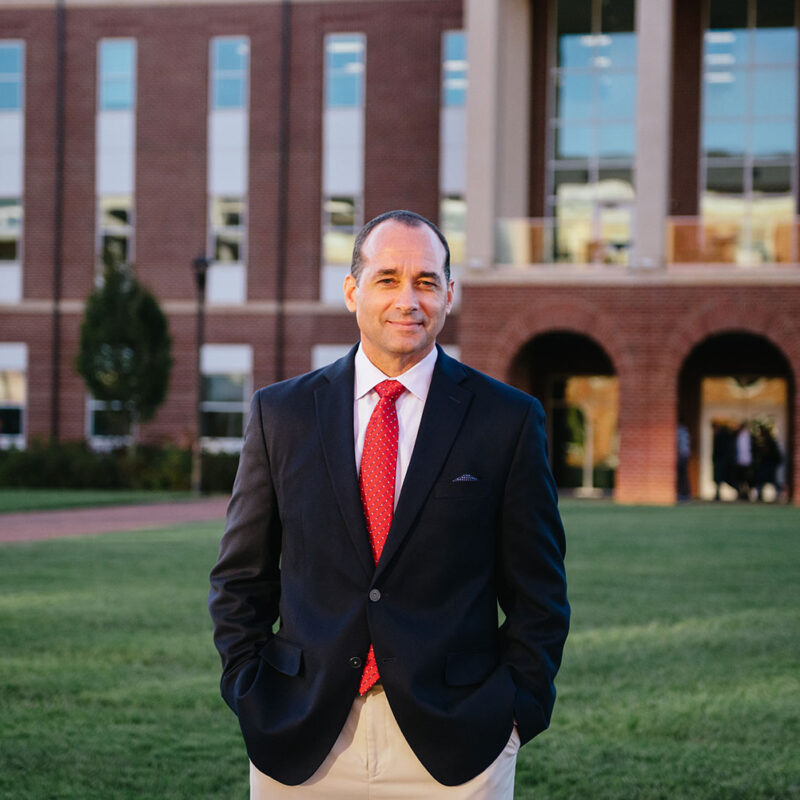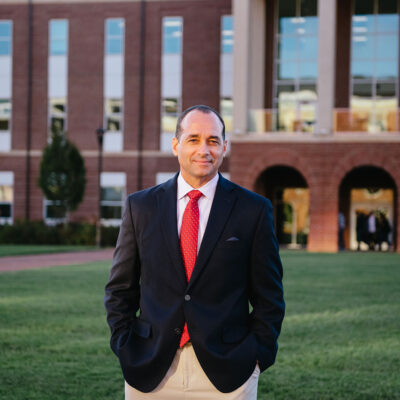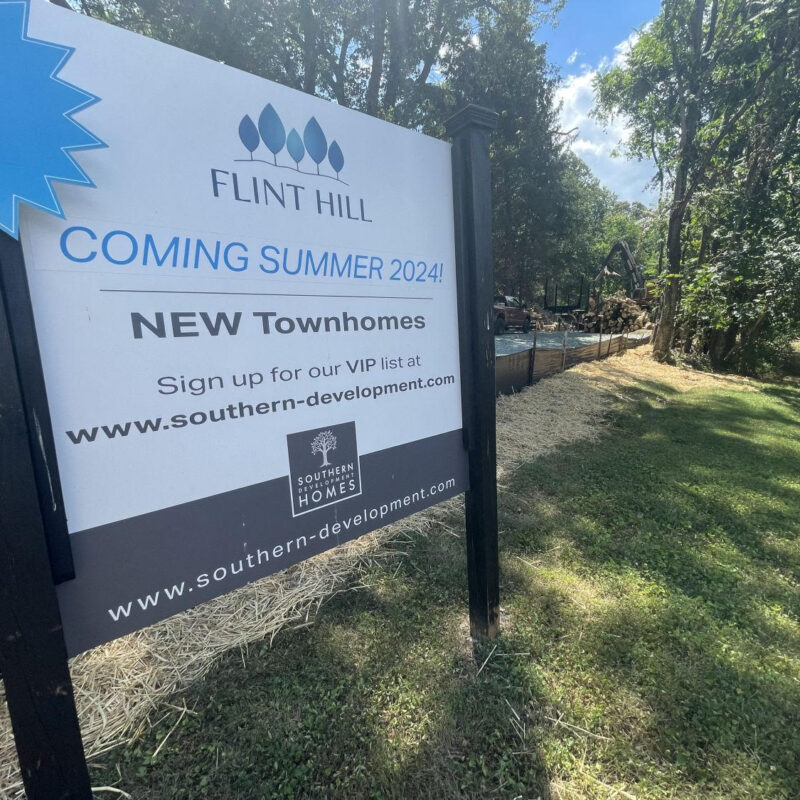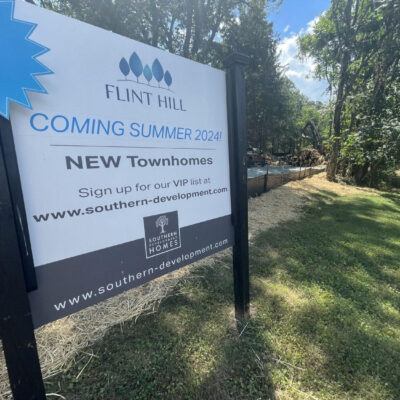Alloy Workshop was formed two years ago this January as a partnership between licensed architect and contractor, Dan Zimmerman, and licensed contractor and carpenter, Zach Snider. In the past year, the firm has added a graphic design studio headed by Zimmerman’s wife, Serena Gruia, to the mix. The firm now has two architects (Zimmerman and 2007 UVA undergraduate in architecture, Andrew Daley), two carpenters (Snider and Gerald Soriano) and two graphic designers (Gruia and Wes Webb) on the team.
Alloy’s fresh and contemporary work—bold colors and statements on the graphics side and lots of industrial materials and salvaged wood on the design and build side—speaks for itself, as do their many admiring colleagues and clients, and we outline a lot of that work and those comments in the images and text that follows. But what makes Alloy so interesting to us, particularly over this past crummy financial year when a lot of us are happy just to have a roof over our heads and couldn’t care less if that roofline is gable or Dutch hip, is that the folks at Alloy aren’t just sitting in their aesthetically pleasing ivory tower (actually, it’s a very cool, semi-industrial space on E. Market Street), churning out pretty places and projects for the well-to-do. In fact, none of them does much sitting around at all (though we forced them to for this photo shoot). Individually and as a group they seem to be out and about everywhere, crossing design disciplines, blurring the lines between work and play and creating a new model of what it means to be a vibrant, productive member of our society.
|
To design and build: Alloy’s structural highlights of 2008 Zimmerman’s overhaul of a 230-year-old cabin in Winchester, Virginia was selected by Cottage Living magazine as one of the top 20 renovations of the year (it came in at No. 6). |
When chatting with the Alloy folks about their latest projects, it’s never entirely clear where their professional lives end and their personal lives begin. Alloy’s monthly newsletter, A is for Alloy, gives just as much space and detail to such extracurriculars as their members’ band gigs and favorite new music as to their day job accomplishments. Snider plays bass for Straight Punch to the Crotch and Soriano plays upright bass for the Downbeat Project; four are avid skate boarders (Gruia, Snider, Webb and Zimmerman); one is a budding urban farmer and mobile chicken tractor designer (Soriano); another is a DJ (Webb, a.k.a., Western Front); two are IRWIN Ultimate Tradesman semifinalists (Snider and Zimmerman); and one is a Charlottesville Lady Arm Wrestling (CLAW) champion—that would be Gruia, a.k.a., Bridezilla. And when any one of them is on his or her respective stage, the others are there too, cheering in the audience. Soriano puts it much better than we could when he describes Alloy’s myriad pursuits and support of each other’s personal endeavors as “the next level of community.”
Like many of their Generation Y-ish peers, the folks of Alloy seem to have some kind of millennial optimism that keeps them energized and underpins a social consciousness that pervades their lifestyles both on the clock and off. Each of Alloy’s members is a ball of creative energy spinning around town leaving freshly designed stuff and good vibes in their wake. They are young, hip, passionate and humble too.
“What blows me away about Alloy,” says Charlottesville Community Design Center’s executive director, Jane Fisher, who has worked with Alloy on numerous design projects, both professional and volunteer, “is just how creative they are. There is this endless flow of cool things. They can do slightly trendy but also thoughtful, sustaining design.”
On top of that, Fisher says they’re a blast to work with.
“All of them have so much energy and a sense of playfulness and fun that you don’t find in a typical firm,” says Fisher. “When I heard about Serena pretending to have a baby in front of everyone as Bridezilla, I thought, well of course she did that. That’s so Serena.”
There may be a professional or life lesson in Alloy’s approach to company structure and community involvement. On the other hand, Alloy might just be an example of a specific group of go-getters who just happened to make magic when they got together.
The spirit of Dan and Zach
The best way to observe how all the unique Alloy elements come together is to visit them at their hub. Here’s the scene on a recent visit to Alloy’s offices: Indie music plays in the background while Gruia and Webb chat between their computers mere inches away about current projects for Big Jim’s Bar-B-Que and Retail Relay, and Zimmerman, Daley and Snider huddle over Snider’s iPhone to see the pics he’s just taken of a residential renovation project he and Soriano executed earlier that morning. The pic is of a media wall of custom built cabinetry designed by Zimmerman on a new Durock cement board wall—a material that typically is used as a base panel for tile or glass mosaics, but in this case has been used to create an industrial-looking finished surface. In the photo on his phone, Snider has circled one of the images with what looks like a fluorescent highlighter pen. “Is that a free app?” Gruia shouts across the room, which begins a lively discussion of how much they all love their iPhones.
Hanging out at Alloy, you get a sense that this is how every office would run if the 20- and 30-something right brains were in charge. Oh, there are white boards and Post-Its just like any office space, but the place is open and airy and happy. There are no cubicles or corner offices to delineate the partners from the lower-on-the-totem-pool types. There’s nothing that really delineates the different disciplines either. Everyone sits in one room and can’t help but cross-pollinate each other’s projects.
|
|
In one sense, the making of Alloy is an example of any small town story of organically grown success, where networks are easily made and the cool people always seem to find each other. Someone plays in a band with someone’s friend. Someone went to college with someone and high school with someone else. Connections among the Alloy members are numerous, and each of them has a similar story of coming to Charlottesville from bigger cities and/or bigger companies, looking to do something different with their professions and their lives—to have more control over both.
Formwork Architecture principal Cecilia Hernandez Nichols, a fan and client of Alloy’s, probably describes the unique fusion best when she says the design-build/graphics firm may have formed as “an accident of historic circumstances,” but she says, “it really started with the spirit of Dan and Zach.”
Before the twosome teamed up, Zimmerman had left a position as an architect in New York to go out on his own in Charlottesville as Zimmerman Design/Build. Snider had fallen into carpentry after working in the sustainable forestry and logging industries in New England and had cut his teeth in his new trade working locally for Ace Contracting before striking out on his own as Irons Construction.
“I didn’t need a construction partner, but it made sense to partner with someone with overlapping and complementary skills. At least three different people suggested that Dan and I meet before we actually did,” says Snider.
After months of Zimmerman and Snider living somewhat parallel lives, doing designerly build projects of the modern persuasion in and around Charlottesville and Central Virginia, that fateful meeting finally occurred at a 2006 Christmas party held by mutual friend and Snider’s Straight Punch band mate Gene Osborn. Of course Snider and Zimmerman hit it off as everyone expected—the architect who likes to build and the builder who likes architecture, and two 30-something guys who like the same kind of music and skateboarding.
After that meeting, Zimmerman and Snider spent a few months helping each other out with their independent projects, including on Laurel Grove Road—Zimmerman’s modern overhaul of a 230-year-old cabin in Winchester, which Cottage Living magazine later hailed as one of the top 20 renovations of 2008—until they realized they were on to a unique design-build relationship that would be served best by fully joining forces, and thus, Alloy was launched.
Better design-build
The concept of a single firm or practitioner that both designs and builds or designs and acts as the general contractor is not new—there are plenty of companies that market themselves as providing a version of design-build these days. Many of them, however, have bastardized the original concept from one of providing both unique design and careful and sensitive execution of that design to one of giant general contractor firms that pretty much provide cookie cutter designs with a few custom features (think of your higher end big home builders in this regard). Alloy is one of a few local design-build shops that stays true to the purer form. At Alloy a licensed architect knows how to and wants to get his hands dirty in the build, a skilled carpenter has an interest and affinity for the design and architecture of things and either one can serve as the general contractor of the project. The melding of the two disciplines can provide for an efficient, more fluid process than the alternative structure where an architect designs a project and then vacates the scene while a separate contractor bids to build the work and decipher the plans.
“Unlike when an architect has to hand off a project to a separate contractor, when you’re doing both the design and the build, you can make adjustments and improvements in the field,” says Zimmerman.
While some industry critics of the design-build method suggest that the design process can get short-changed by the ability of the design-builder to make things up as he goes along during the build phase, it’s easy to see how this process can be much more efficient than one where a contractor or builder works in a design vacuum with no access to the designer of the plans when execution problems arise.
Not only is this kind of on-site efficiency helpful for your average clients, who often find it makes the overall cost of the project cheaper, but these kinds of small design-build firms are popular with other architects, who’d rather hand off their vision to a contractor who has design sensitivities than to one who doesn’t know about design or doesn’t care.
Although architects can’t dictate the contractor their clients choose, they can make recommendations strenuously. That’s probably why Zimmerman and Snider have already executed designs for some of the most admired fellow modernist architects and firms around here, including Formwork, Wolf Ackerman and W.G. Clark.
“Zach has an amazing affinity for all things carpentry—the way he moves and how he works—it’s very Zen, like the old style woodworkers. He doesn’t seem to get frustrated, and he’s very accurate, I really liked working with him,” says Nichols, who hired Snider to do carpentry work on her own home before when he was still working alone as Irons Construction.
When Snider later told Nichols that he planned to partner with an architect, Nichols, who didn’t know Zimmerman at the time, says she gave Snider a few words of caution about getting into business with a partner. One concern might have been whether aligning himself with one architect would mean Snider wouldn’t seek out architecturally minded carpentry and contractor projects by other designers. So far that hasn’t been the case, as Alloy has continued to provide contractor and carpentry services for projects designed by other local architects, most notably and recently, a residential kitchen renovation designed by nationally renowned modern architect and UVA Architecture School professor, W.G. Clark (that renovation was for local landscape architect Gregg Bleam and was featured in our December issue of ABODE).
Now a fully converted fan of Alloy, Nichols says: “My interest in them and my enthusiasm for them is that they are an integrated design studio, and in our practice, we strive to integrate across design disciplines. Their lifestyles plug in, too. The construction guy plays in a band and has this whole artistic side—Dan has spent a lot of time on construction. They can have conversations with each other. They can help the other see past the veils of their own professions.”
Upping the Alloy ante
Alloy was already onto something unique with the partnership of Snider and Zimmerman, but the multidisciplinary design-build shop achieved a whole new level of innovation when it added Zimmerman’s graphic designer wife, Gruia, and a second graphic designer, Webb, to the firm in January 2008. Gruia, who graduated from Virginia Tech with an urban planning degree and had worked for a design firm in New York, already had been doing some graphics work locally through her printing company Little Tree Press. While her marriage to Zimmerman certainly must have contributed to the decision to fuse their businesses, it may be more about the fact that as a couple they could see the daily symmetry in their interests and skills than the fact that it would make for easier marital bookkeeping.
“It’s a great marriage in more ways than one,” says Fisher, who has worked with both Gruia and Zimmerman individually and collectively through the CCDC.
Nichols similarly understands the power of an architecturally sensitive and connected graphic designer. She recommended Gruia to two of her architecture clients for whom Formwork has created much-admired restaurant designs: Coran Capshaw for TEN and John Adamson for Boylan Heights.
“When we were working on TEN, I knew we needed to have a graphic designer on board way ahead of the opening, someone who understood what we were trying to do,” says Nichols. “At Boylan Heights we had the same interest in making the marketing materials match the design we were trying to create. Serena understands design from the graphics side and can offer architectural critiques.”
Nichols says that if commercial clients such as restaurateurs don’t take the graphics part of the package seriously, the entire design of the place can fall flat.
Adamson says he and his partners, Andrew Watson and JR Hadley easily understood the stakes associated with the graphics for Boylan Heights—a space that thanks to Formwork and the vision of Adamson and his partners, has ratcheted the college bar sentiment up several notches by giving the dark leather booth/ college tavern cliché a more contemporary edge with more modern finished materials, color schemes and lighting—but he says, “I didn’t know there was anyone in town who did that kind of work.”
It wasn’t until Adamson and his partners realized that the name they’d come up with on their own—“The Burger Joint”—wouldn’t fly because an eatery in the D.C. area already had the name that they sought Alloy’s help on the recommendation of Formwork.
“I needed a name so I could concentrate on more important things,” says Adamson. “I told them [Gruia and Webb] the concept—boarding school with an edge—and they were so good at coming up with something that nailed down the prep school look we were going for without being too themey.”
As it turned out, what began as a restaurant name brainstorming session where Adamson answered seemingly random questions from Gruia and Webb, such as the names of his favorite bands and towns etc., turned into a full-scale marketing scheme for Boylan Heights (incidentally the name of one of Adamson’s favorite 1980s bands and a favorite neighborhood in Raleigh from where the band hails). In addition to the logo, Alloy designed t-shirts, menus made to look like Scantron testing sheets and even designs for the signs indicating the boys and girls rooms—flirty schoolgirl and schoolboy stick figures, which had to be replaced within a few weeks of opening because someone thought they were cool enough to steal.
Nichols says that Alloy’s multidisciplinary design services are similar to a European model where, she says, “there is a much more fluid concept of design.”
“Traditionally in other cultures, particularly in Italy, all designers came out of the same schooling, so they could design a fork or a house. We are much more compartmentalized in this country,” she says.
One large and well-known example of a Europe-based multidisciplinary design firm is Pentagram Design, which was founded in London in 1972 and now has several offices worldwide, including the United States. Pentagram combines graphic designers, architects and industrial designers in one network. The design studios are still separated by practice areas, but by combining forces under one umbrella, Pentagram designers can collaborate with other disciplinarians more easily and provide clients with access to a broader range of services.
At Alloy, by contrast, the graphic designers literally sit next to the architects and the architects sit next to the builders—or else they work alongside the builders out in the field—and so ideas are bounced off each other every day. Each designer brings his or her perspective to a firm project and, arguably, each of them becomes a better designer in his or her own discipline simply by constant exposure to the others.
“Everyone wears each other’s hats,” says Daley, who admits that as a 23-year-old recent undergraduate, he has an unusual amount of design responsibility for his stage of professional development, much more than he would have if he’d gone the route of many of his UVA peers: straight to architecture graduate programs and on to big firms where he says relationships between the new architects and the principals are virtually nonexistent.
“I sit next to Dan all day, and he’s totally open to having conversations when I’m sitting there at my computer or out in the field.”
Concurring with the unique opportunities at Alloy, Webb, says “This is my dream job.”
A 2005 graduate of the studio arts program at James Madison University, Webb moved to Seattle with four fellow JMU alums in 2006 to start an interdisciplinary design firm very similar to Alloy, interestingly enough. It was the right concept, obviously, but the wrong people. The company imploded within two months. Webb attributes that to personal conflicts and professional differences among the members. Getting the job at Alloy, then, seemed like Webb’s fate, and it was easy once he proved himself a kindred spirit to Zimmerman, Gruia and Snider. It was the scrappy ingenuity of his thank-you note, of all things, that probably sealed the deal for him. After interviewing for Alloy, Webb created a mini replica of Zimmerman’s Laurel Grove cabin on paper designed to be cut out and folded by numbers to create a 3-D model. Even better, to illustrate his willingness to cross disciplines and get his hands dirty, Webb hand made a small wooden box to hold the paper model. Within about 48-hours of receipt of the note, Webb had the job.
The mini Laurel Grove model now sits on a shelf in Alloy’s office—it’s one of many hidden treasures and trinkets in Alloy’s offices on E. Market. Almost mimicking the demeanors of the participants inside, the exterior of the space is modest and unassuming, but the inside is utterly cool and contemporary, yet comfortable and approachable. Zimmerman increased the pitch of the roof and added new 5-V metal panels to the ceiling. To balance the cold sleekness of the metal, the walls have been covered in narrow wood planks from old shipping crates, many of them leftover from international shipments of oriental and Turkish rugs to a local rug shop.
It was practically on the strength of Alloy’s creative and budget-conscious office design alone that Gael Hoerr says she hired Alloy to turn her two-car garage in Bellair into a pool and guest house—one of the firm’s most recent projects and the first to fully utilize all three of Alloy’s disciplines.
Hoerr had hired Gruia’s Little Tree Press to do some design and printing work and says that when she visited Gruia in the offices Little Tree Press had shared with Zimmerman’s original design-build firm and now shares with Alloy, she says “I was so surprised by how really cool and modern it was.”
Similar to Alloy’s offices, Zimmerman and his team used a blend of cold- and warm-feeling elements on Hoerr’s pool house—concrete on the floors, slate-faced cabinetry on a custom media wall and unfinished wood slats on the ceiling.
Though Hoerr says she absolutely loves the finished product and says Alloy was able to come up with a great design using inexpensive materials, she admits that she initially was a little nervous about some of those material choices.
“I didn’t think it would work, but he just had this vision. The materials balanced each other just right,” says Hoerr.
Another highlight of the project was the addition of graphics to a feature wall, pulling in Alloy’s third strength.
“Dan and Serena picked out all of the wall colors and decided that the blue wall would be a feature wall. I’m a fan of Candace Olson of ‘Divine Design’ on HG-TV and had seen her use these really cool wall panels on one of the shows. I found them, but they were too expensive for my budget.”
Hoerr says Zimmerman and Gruia liked them too and figured out how to create the same look using vinyl wall stickers in a pattern that Serena designed.
“They’re so creative, which is easy to do when you have a big budget, but what so impressed me with them is that they were so creative on a fixed budged,” says Hoerr.
Going the distance
In the relatively short life of Alloy, the firm seems to have been able to find the kind of cool, modern and creative work in which they thrive. Early on, though, Alloy’s members weren’t so sure about their prospects.
“Some people might think they have to go to New York to get good design work, but we wondered, ‘Do we have to go to New York to get good clients?’” says Gruia.
So far that hasn’t been the case. All of their work has been local, which may be partly a result of Alloy finding opportunities to create its own demand for good design, whether or not they get paid for it.
For instance, Gruia and Zimmerman were instrumental forces and volunteers behind the founding of the CCDC, which was formed in 2004 as one of 40 nonprofit community design centers across the country that promote good quality design across the economic and social spectrum. Fisher, who became CCDC’s executive director just two years ago says it seems Alloy and its members “have always been with us—working both professionally and on a volunteer basis. They are always looking out for us.”
CCDC’s residential energy efficiency initiative Spark! in particular was one that impressed Fisher by how far Alloy took the concept. Similar to Boylan Heights, the Spark! project started out as a simple request for a name and logo and grew to a much bigger visual identity and website design project because of Alloy’s sheer creative overflow.
“It’s more than just branding,” says Fisher. “They really understand and articulate what you want.”
Arguably the biggest collaboration between the CCDC and Alloy so far was the Design Marathon, a one day event in October that paired teams of professional and student designers with 10 local nonprofits in need of pro bono design work. Projects ranged from the creation of a new logo and marketing campaigns for the Music Resource Center to a site and landscape design for a low-cost new playground for Children, Youth and Family services. Many of the ideas that came out of the Marathon are already being executed and many of the designers who volunteered on that day are continuing to lend their services to see the projects through to the end.
“The whole event was completely due to Serena and Dan’s vision. They knew how they wanted the whole project to happen and they immediately came to us with the idea,” says Fisher, who expects the Marathon will be an annual event.
With all of Alloy’s youthful exuberance and idealism, they do seem to be on to a new paradigm for not only how to structure a company but how to structure your life’s work. In any case, they are onto to something big. So where to they go from here? Do they want to grow the firm? Design skyscrapers? Go on the motivational speaker circuit? The folks of Alloy give pause and provide somewhat humble answers to questions about their future plans.
“Continue honing my skills and getting a steady paycheck, I guess,” jokes Soriano.
“I’d like to design a wine bottle some day,” says Wes.
Zimmerman is slightly more overtly ambitious with his answer: “A few AIA [American Institute of Architects] awards and some more national magazine coverage would be great.” Also, Zimmerman says he’d love for Alloy to have full reign of a commercial project starting from the site design and proceeding to the build and the graphics and marketing (budding restaurateurs take note).
Other than that, Alloy’s folks likely will continue this next year spending their seemingly limitless energy doing small-scale, cool projects they love, and they’ll likely continue to lend their creative hands to other good works and worthy causes. And when they’re not doing all of that, they’ll probably be rocking it out on the local band circuit and/or gleaming the cube or whatever the skaters are doing these days. All in a day’s work and play.







